My easy sourdough bread recipe is perfect for enjoying on its own or using for sandwiches! I’ll be walking you in detail through every step so you can learn how to make perfect sourdough like a pro. Recipe includes a how-to video!
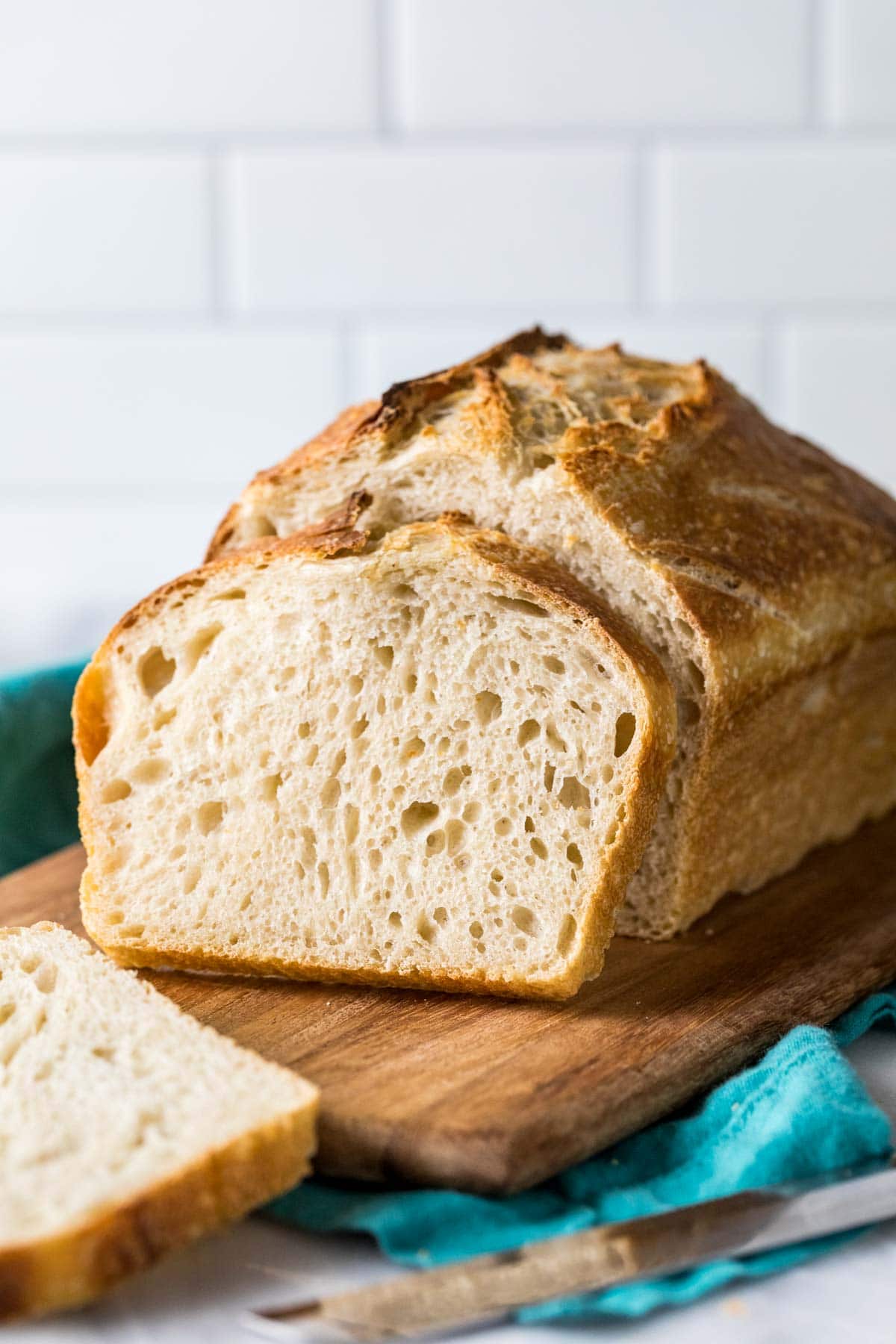
The Best Sourdough Bread Recipe
My easy homemade sourdough bread is the only bread we eat in my household anymore. In fact, I make 2-3 loaves a week and keep a stockpile in my freezer at all times (handy for making sourdough homemade croutons and breadcrumbs)! And once you try it… well, I think you will, too.
That’s because there’s a lot to love about sourdough bread. First and foremost, it has a high nutritional value and none of the additives (no added sugar, either) you’ll find in most store-bought breads. It also tastes amazing: classic, hearty bread (that’s not overly sour) with a thick, crusty exterior and a soft, springy interior.
But what I think you’ll love most about my recipe is how wonderfully versatile it is. It’s ideal both for dipping in soup, serving as a side with a salad, or using as a sandwich; it also makes an awesome grilled cheese that pairs beautifully with my tomato soup!
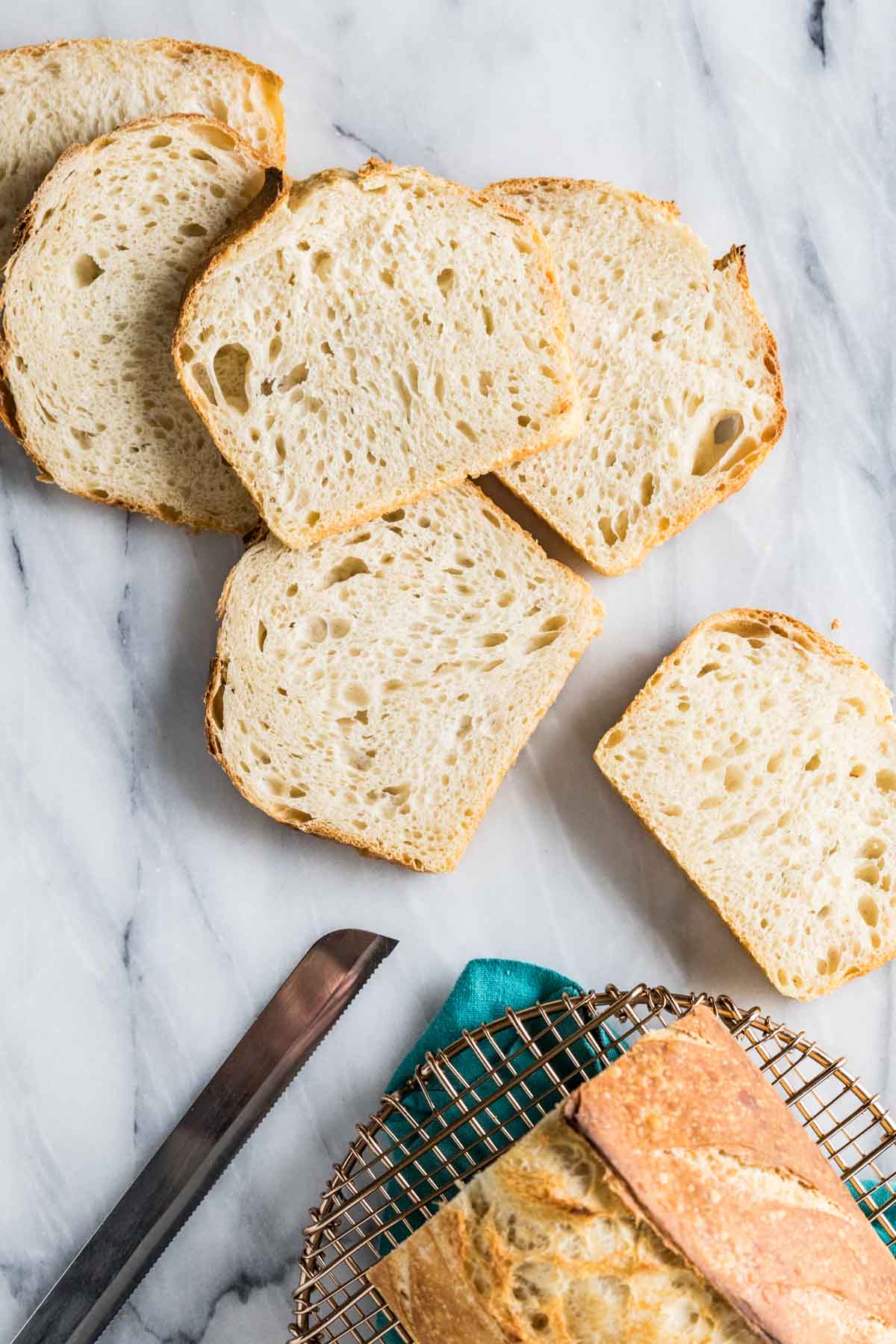
Homemade Sourdough is Easier Than You Think!
Making sourdough bread at home is shockingly easy, especially if you use the sourdough starter I shared last week. It is time consuming and you must have patience, but the work itself is very approachable and I wanted to share a version that was easy to follow–perfect for beginners and advanced sourdough bakers alike.
There’s no kneading involved; instead, we’ll use the easy process of stretching and folding, which develops the gluten much like kneading would, but is better suited for higher hydration dough like sourdough. There’s also no mixer or fancy equipment needed with my recipe — you don’t even need a banneton or a Dutch oven, just a pair of bread pans!
Let’s get started (and after you try it, pat yourself on the back and leave me a comment to let me know how you like it!).
What You Need
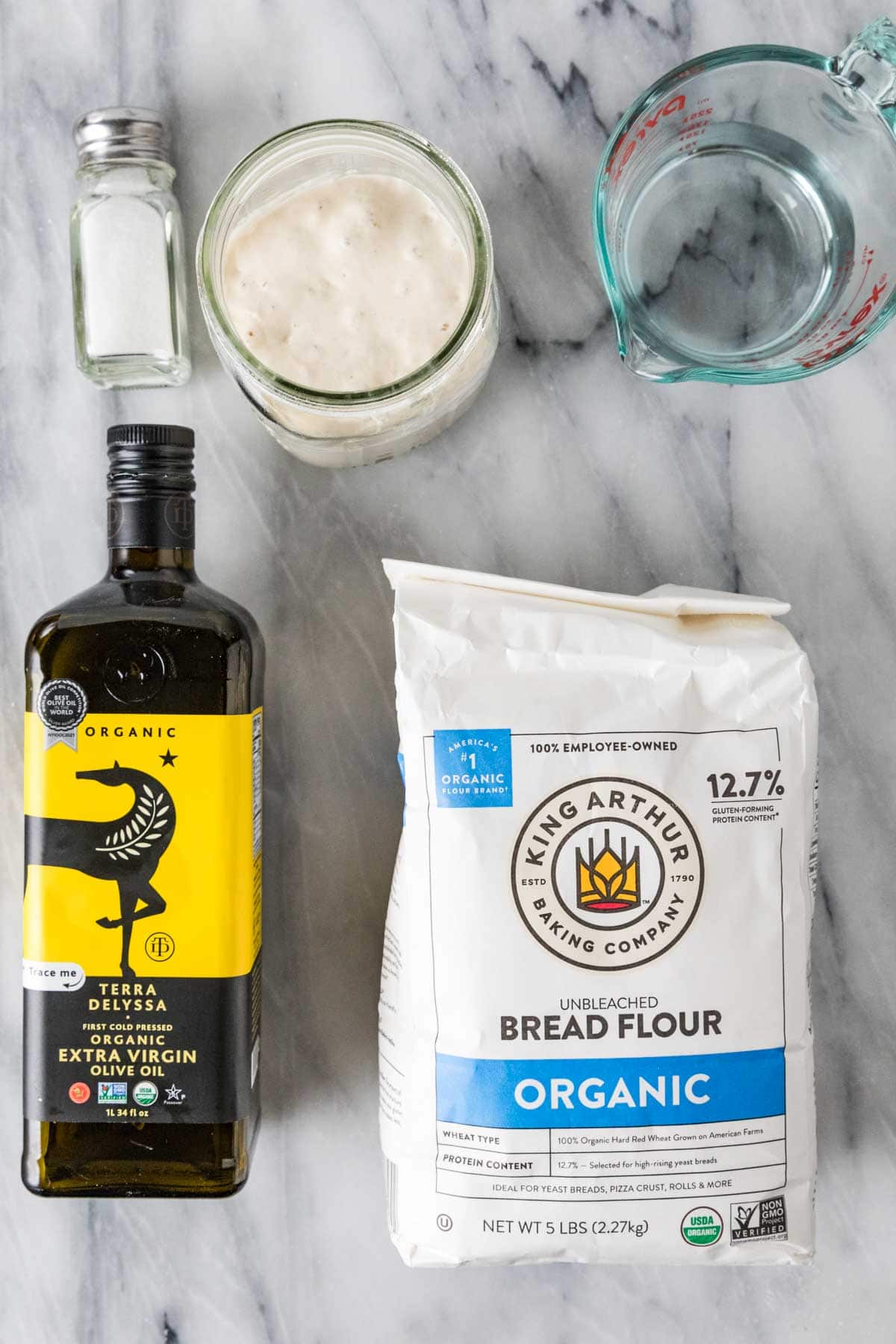
- Sourdough starter. This can be homemade or store-bought. Obviously, I recommend making your own by using my sourdough starter recipe (this does take over a week to prepare, but it’s worth it!).
- Bread flour. I really recommend bread flour over all purpose for my sourdough bread recipe. Bread flour has a higher protein content and produces a better-crumbed sourdough bread, in my opinion. If you don’t have it, all-purpose is not as great but will be “fine”, but try it at least once with bread flour.
- Olive oil. A bit of olive oil helps make the bread perfectly chewy and soft. I also find it keeps my sourdough softer longer.
- Salt. Salt is critical for flavor (unsurprisingly) but it also plays some other important roles in sourdough bread. It helps balance the acidity from our starter, strengthens the gluten in the dough (important for shape and texture), and it even helps extend the shelf life of the bread by acting as a natural preservative. Don’t let anyone tell you it’s going to hinder your yeast, it won’t (or at least won’t to any noticeable degree and your sourdough will be worse off without it).
- Water. The water called for in my recipe will yield a sourdough loaf that is about 70% hydration. I love this hydration level; it produces a crumb that’s neither too dense nor too open, that’s not too sour but is still flavorful, and that is easy to shape and extremely versatile — we use it for everything from dipping in pot pie soup to eating sandwiches. Once you’re comfortable baking a bread at this hydration level, you can experiment with increasing the water if you’d like. More water usually yields a bread with a more open crumb, a more tangy flavor, and a crumb that’s less suitable for sandwiches but good for dipping.
I wrote this sourdough bread recipe with weights because I find it’s the easiest way to make it (just like with my macaron recipe); however, I have included cup measurements as well.
SAM’S TIP: While some people like to bake their sourdough bread in a dutch oven, I like to use a pair of bread pans. It doesn’t look as rustic this way, but it’s much more practical for my family to have a loaf of bread rather than a round of it. If you’re team Dutch oven, don’t worry–I provide instructions for how to make sourdough bread in a Dutch oven below.
Remember, this is just an overview of the ingredients I used and why. For the full recipe please scroll down to the bottom of the post!
How to Make Sourdough Bread
Make the Dough
The first 4 steps in my sourdough bread recipe are the “autolyse” period (or sometimes called an “inclusive autolyse” because we are incorporating all of our ingredients at this point). This step helps boost fermentation, improves the texture (more open crumb!) and flavor, and makes the dough easier to work with.
Note that I do, quite intentionally, include salt in this first step. Some bakers argue that salt will inhibit the yeast growth and negatively impact the crumb. Not so! With the duration of this autolyse and the composition of this particular sourdough bread recipe adding salt at this stage does not make a difference. Leaving it out for this step only makes it more difficult to incorporate later and increases your likelihood of accidentally forgetting to add it altogether (which would be a shame!).
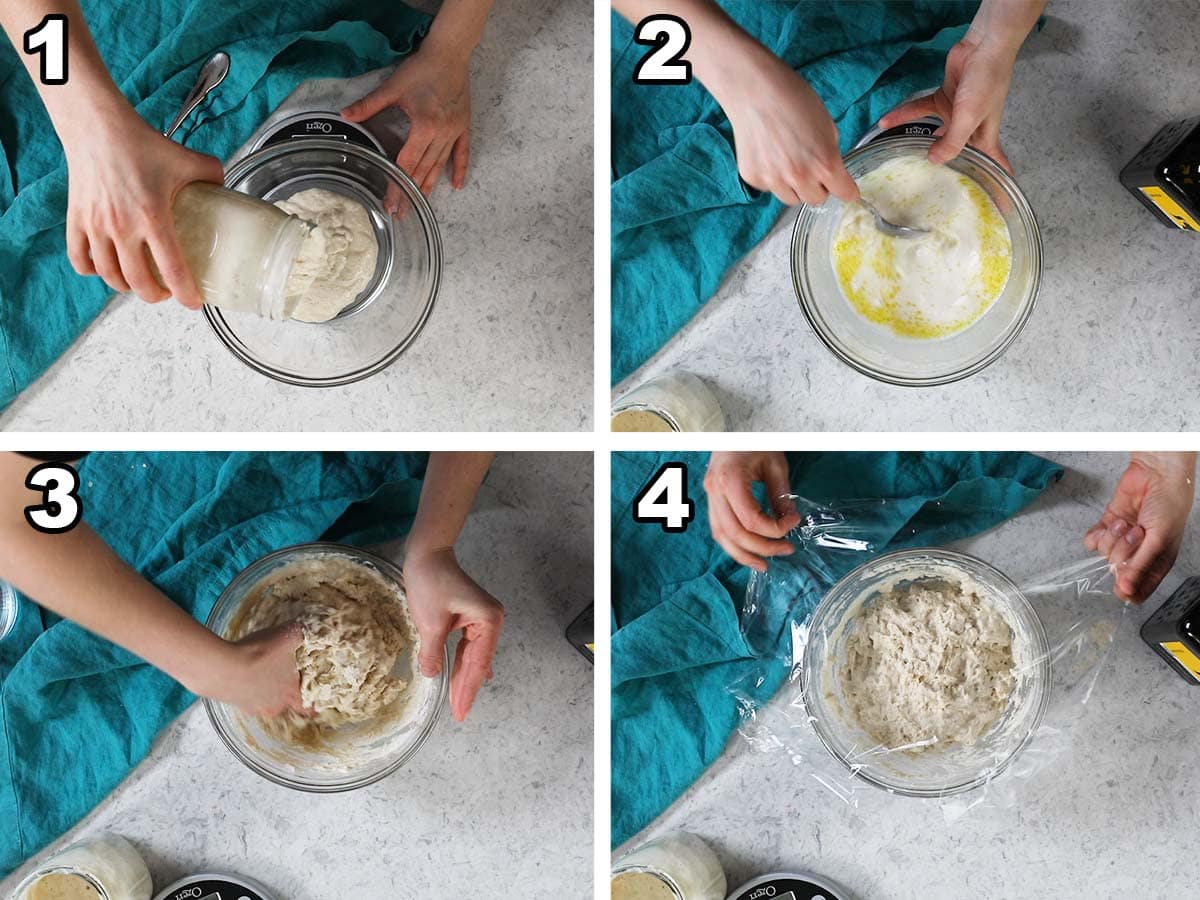
- Combine sourdough starter, water, and oil in a large bowl. Make sure your starter is active and bubbly before adding it.
- Add the bread flour and salt.
- Stir until mostly combined (your dough will still look shaggy). Do not over-mix!
- Cover and let sit at room temperature for one hour.
Stretching & Folding Your Sourdough
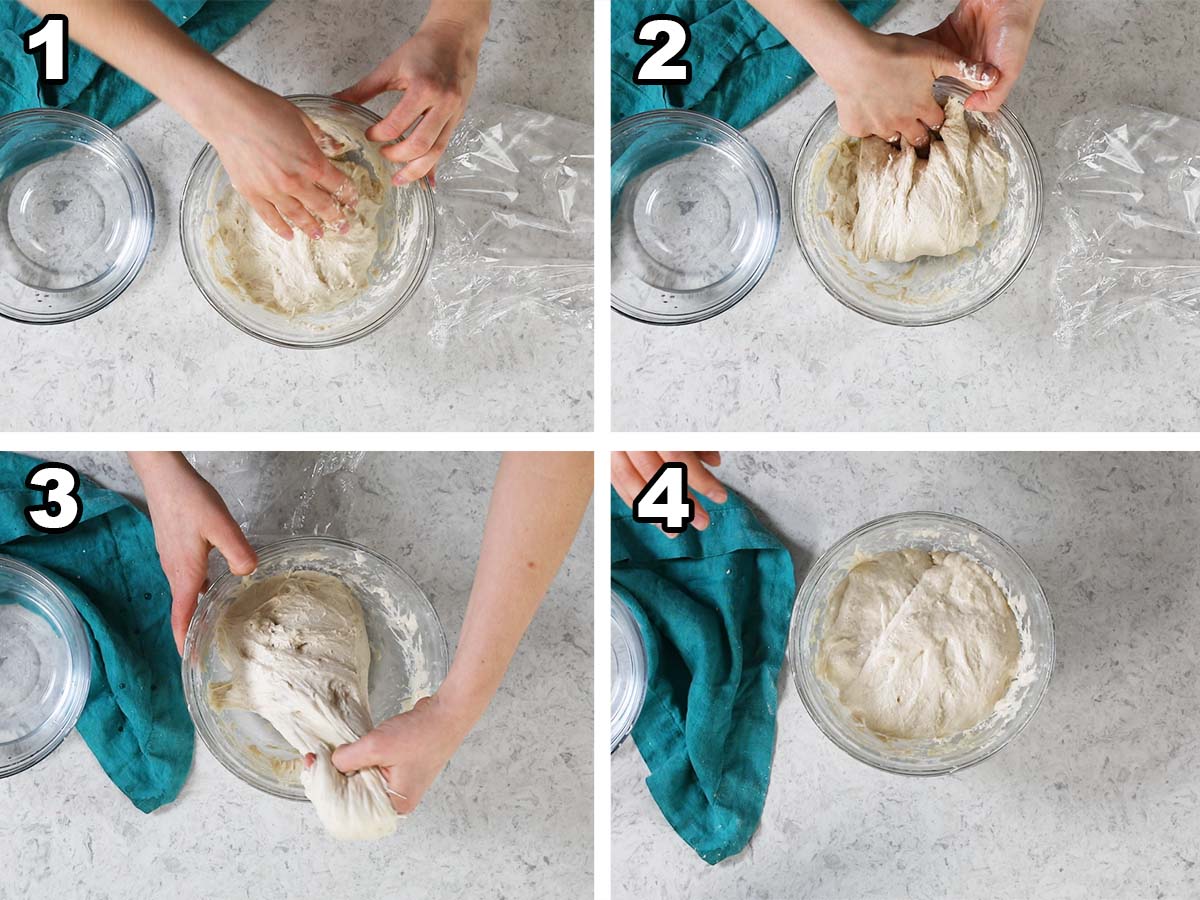
- Form your dough into a ball using your hands, the run your hands under cool water.
- Stretch the top of the dough up and over the bottom, then turn the dough 90 degrees and repeat. I demonstrate this in the video below if you need a better visual.
- Repeat the stretch and fold process a total of four times, then cover and place in a warm place to rise for 30 minutes.
- Let your dough rise until increased in size by 80%, repeating the stretch and fold process every 30 minutes.
Assembling
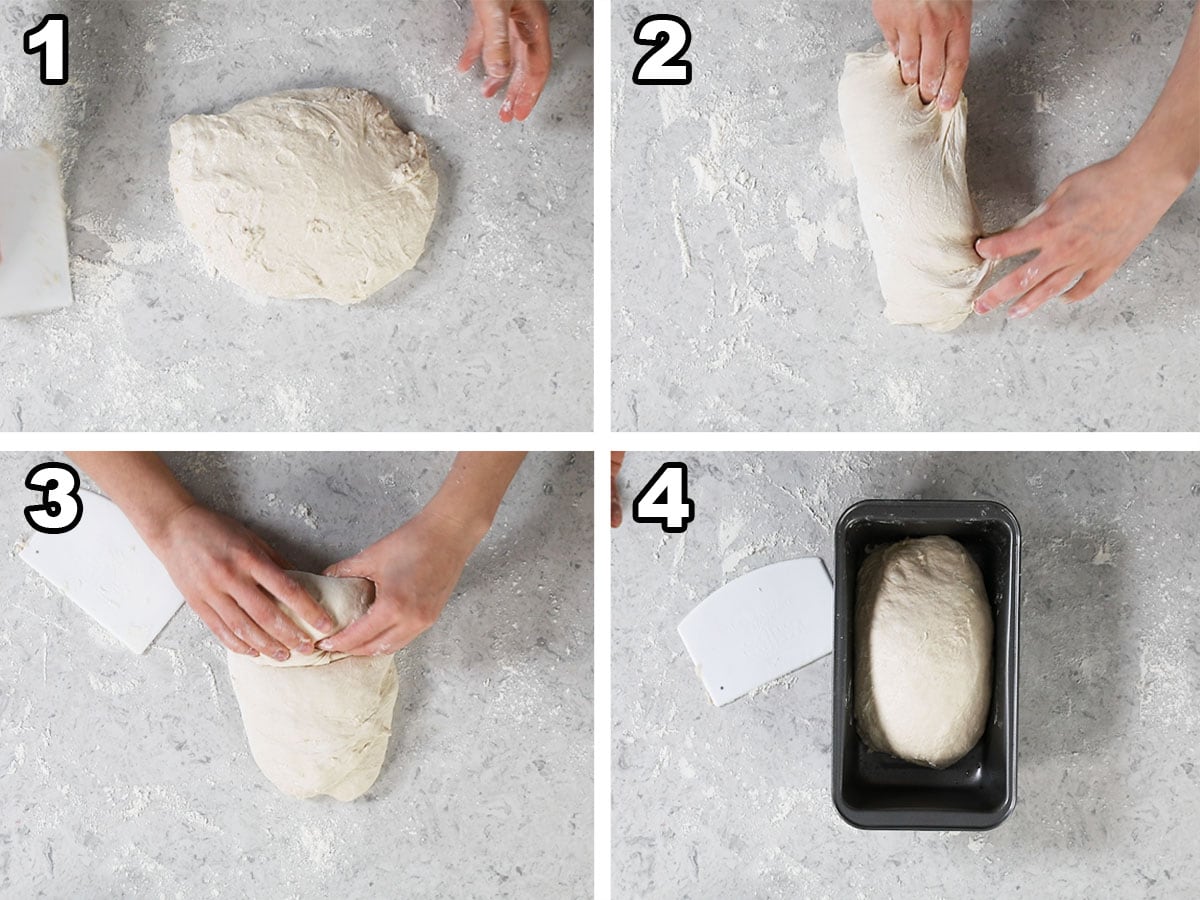
- Deflate and form your dough into a rectangular shape on a lightly floured surface.
- Lift the right side of the dough, fold it over to the center, then repeat with the left side (like folding a paper in thirds).
- Roll into a tight log starting with the short end of the rectangle, then tuck the ends under.
- Place in a greased bread pan, cover loosely, and place in the fridge to rest overnight.
SAM’S TIP: I recommend proofing your dough in the refrigerator overnight rather than baking right away (I also provide instructions for baking right away, though). Proofing overnight will help develop the flavor, help the bread rise better, and encourage more fermentation. That being said, I don’t like to let my dough sit in the fridge for longer than 48 hours (absolute max) before baking. Letting it sit too long can cause over-proofing and can compromise the final texture of your sourdough bread. I also don’t freeze my dough before baking, so I can’t advise on that.
Baking
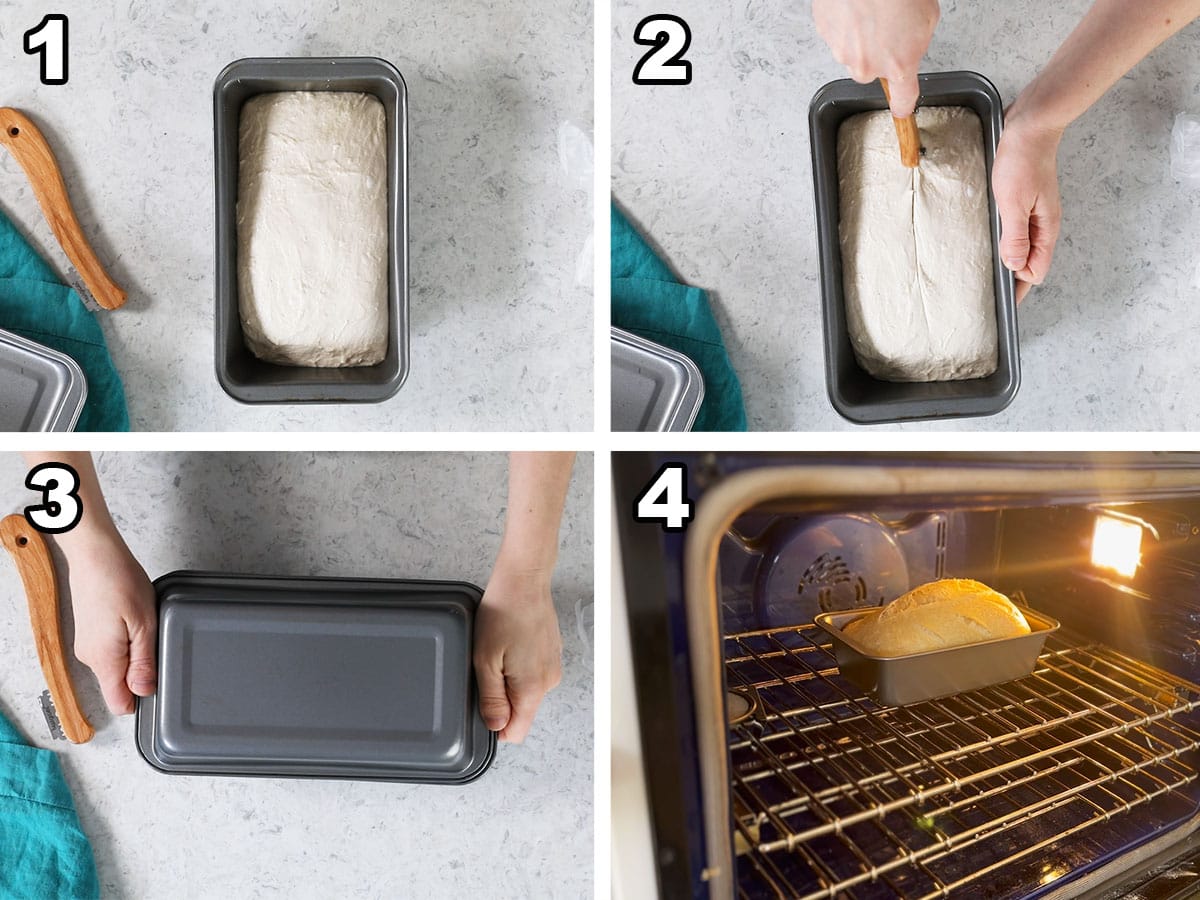
- Let the dough rest at room temperature while your oven preheats.
- Score the bread about ¼″ deep down the center.
- Cover with another bread pan or an aluminum foil tent.
- Bake at 450F for 30 minutes, then remove the cover and bake for 20-23 minutes or until the bread reaches an internal temperature of 206F (97C).
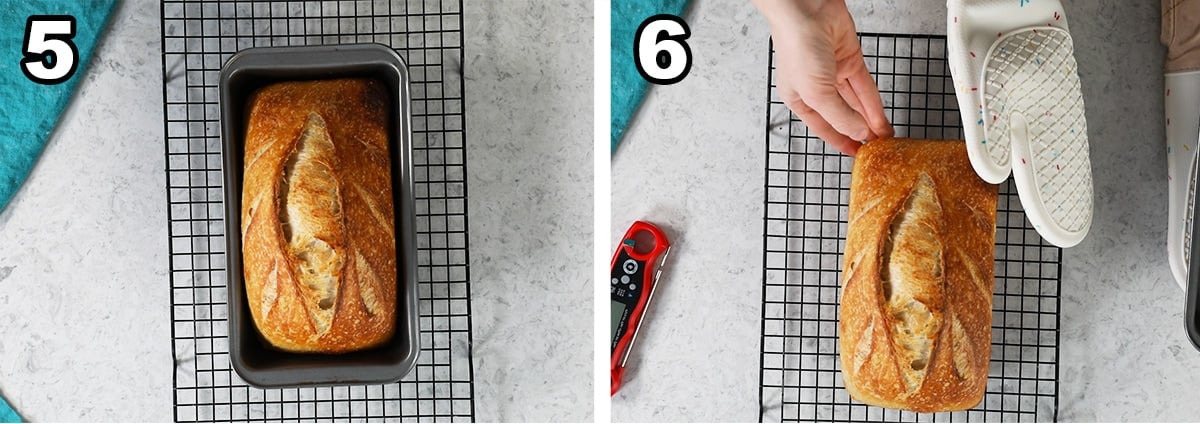
- Let the bread cool in its pan for 15 minutes.
- Remove the bread from the pan (carefully, it’s still hot!) and place on a cooling rack. Don’t let it sit in the bread pan too long, or your sourdough bread could end up soggy from the steam that it releases in the pan that can’t escape. Once removing to a cooling rack, allow the bread cool completely (or at least almost completely) before slicing.
SAM’S TIP: Don’t cut into the bread while it’s still warm (I know, so hard, so tempting!). Doing this can make your loaf gummy and dense.
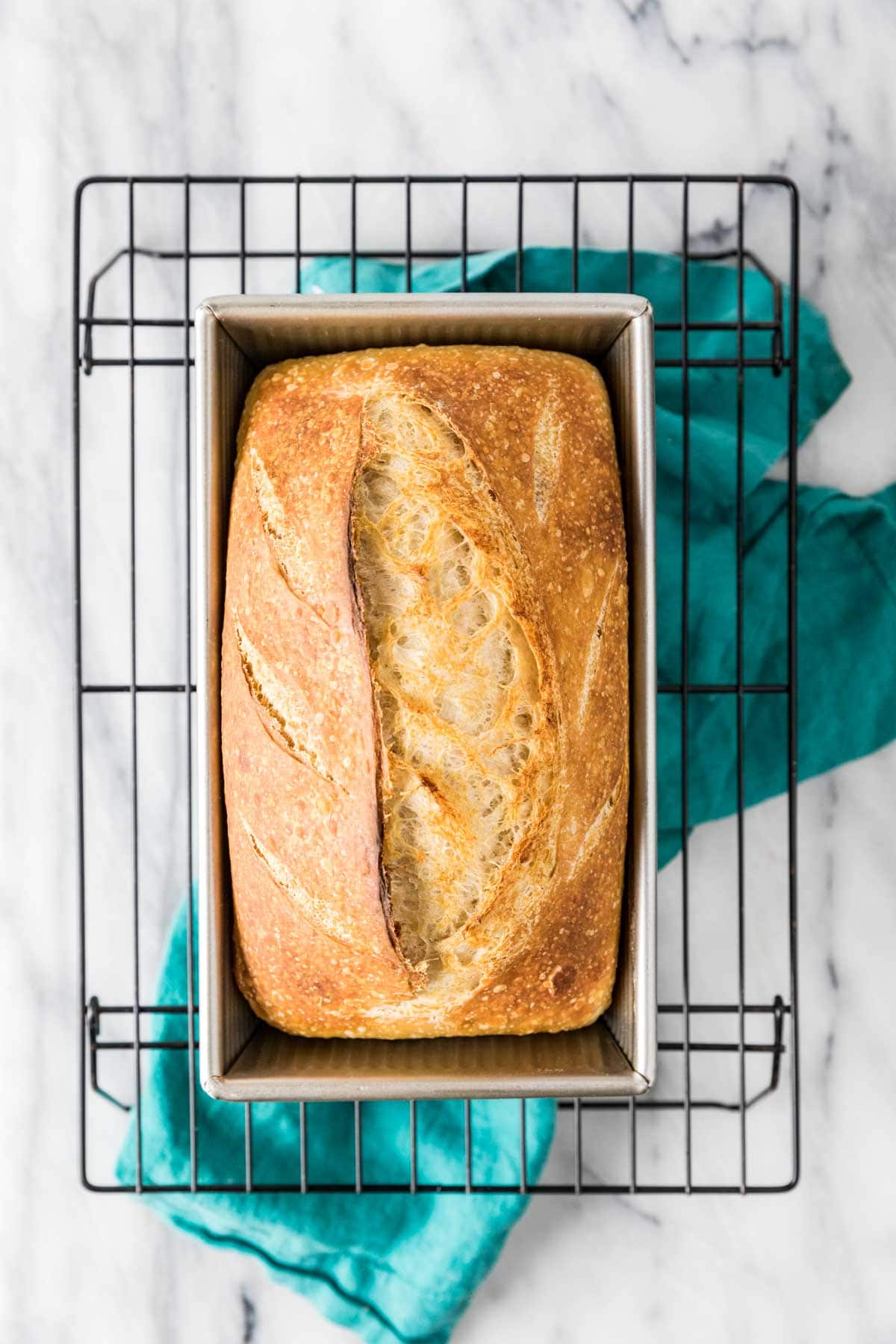
Frequently Asked Questions
Sourdough is definitely one of the more nutritious types of bread. It’s prebiotic-rich, made by fermenting dough with wild yeast and bacteria (sounds not-so appetizing but in reality is delicious) and is more digestible than your standard white bread. It also has a lower glycemic index and less gluten than normal bread. If you’re going to be indulging in bread, this is arguably a better option than standard white bread.
While a traditional sourdough bread recipe is obviously not gluten free, sourdough bread is sometimes tolerated by people who are gluten sensitive (but not people with Celiac Disease). This is because some of the gluten is consumed during the fermentation process, which makes the bread more easily digestible.
Yes, of course! I wanted to share an easy sourdough bread recipe that can be made with basic kitchen equipment, but you can just as well use a Dutch oven. Follow the written recipe through the rolling and tucking step, then place the dough in a lightly floured banneton (I use my Kitchenaid mixer bowl lined with a lightly floured kitchen towel, because I don’t actually have a banneton). Cover and let rise overnight in the fridge.
The next day, carefully turn out your dough onto a large piece of parchment paper and carefully lower this into a 4.5qt Dutch oven (a larger one would work, but your bread will be flatter and will likely cook faster). Allow the dough to sit uncovered while the oven preheats, then score, cover with a lid, and follow recipe instructions for baking.
You can preheat your Dutch oven (as I do in my artisan bread recipe) to make it nice and hot before adding your dough if you’d like, but honestly I rarely do this step with this recipe.
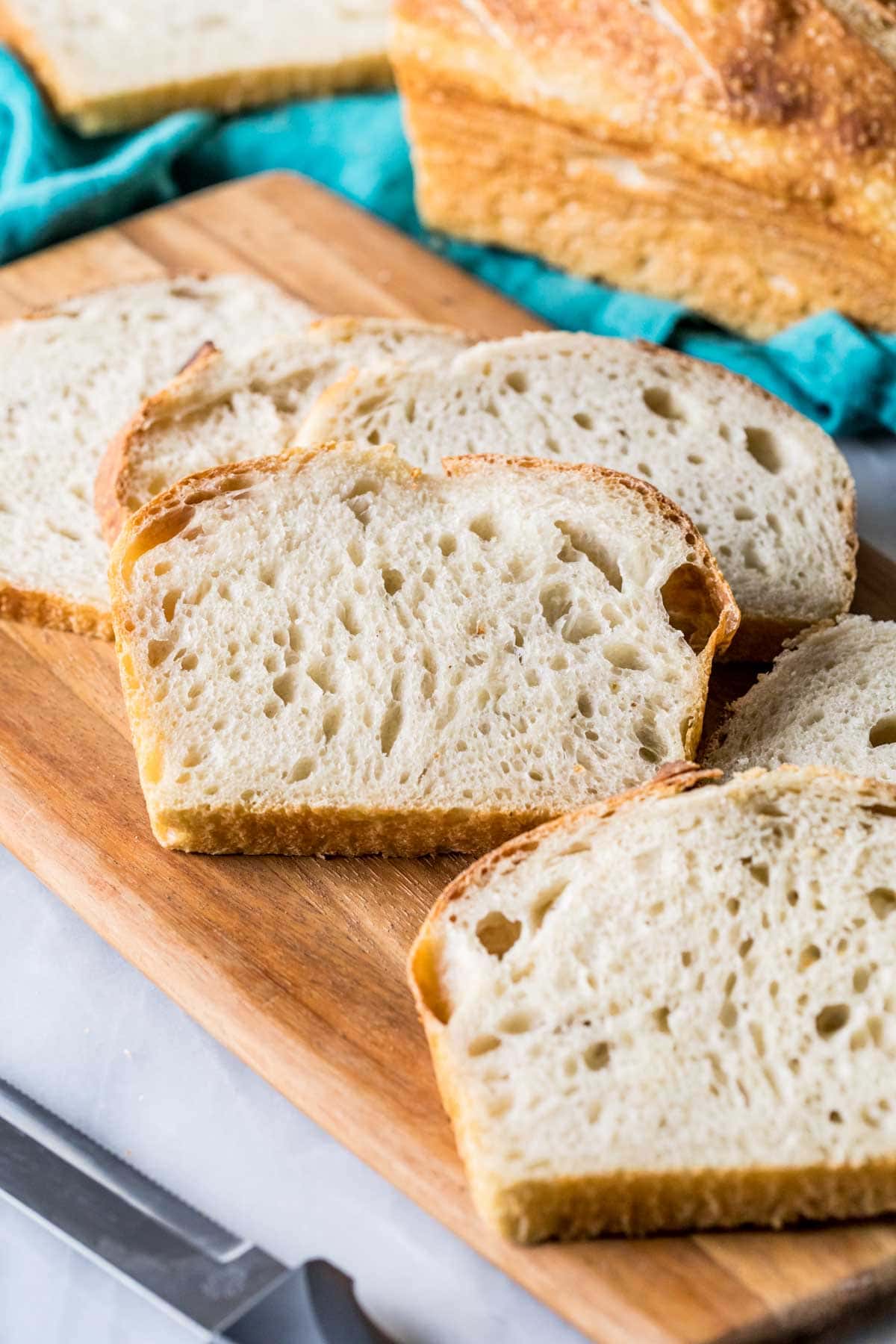
I know that there are many sourdough bread recipes out there and so many different ways to make it, but this is my personal favorite version that I’ve carefully developed over the past year. I can’t wait to hear how you like it (let me know in the comments!), I hope you’ll always want to keep a loaf in your house, too! ❤️
Enjoy!
If you try this recipe, be sure to tag me on Instagram, and you can also find me on YouTube and Facebook
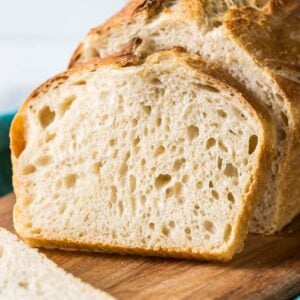
Sourdough Bread Recipe
Ingredients
- ⅔ cup (150 g) active starter bubbly, active, fed
- 1 ⅓ cups (315 g) warm water 90F
- 1 ½ (18 g) Tablesoons olive oil
- 3 ⅔ cups (450 g) bread flour
- 2 teaspoons (13 g) table salt
- Oil for greasing pan
- Additional flour for dusting work-surface
Recommended Equipment
- Bread lame (optional, or use sharp knife)
Instructions
- In a large mixing bowl, combine sourdough starter, water, and olive oil. Stir until combined.⅔ cup (150 g) active starter, 1 ⅓ cups (315 g) warm water, 1 ½ (18 g) Tablesoons olive oil
- Add bread flour and sprinkle salt overtop. Use your (clean) hands or a wooden spoon to stir together until dough is mostly combined. It will still be a bit shaggy and should not be cohesive (don’t over-mix) but no dry patches of flour should remain.3 ⅔ cups (450 g) bread flour, 2 teaspoons (13 g) table salt
- Cover bowl with plastic wrap and let sit undisturbed for one hour (this is the “autolyse” period).
Stretch & Fold
- Form dough into a ball with your hands.
- Run your hands under cool water (prevents sticking!) and grasp the top of the dough and stretch it over the bottom. Turn the dough 90 degrees and repeat. Turn 90 degrees and repeat again, then once more (four total stretch & folds).
- Allow dough to rest, covered, in a warm place for 30 minutes.
- Repeat step 2 above every 30 minutes as dough rises.
- Allow dough to rise (stretching and folding every 30 minutes as indicated) until dough has increased in size about 80% (how long this takes depends on the temperature of your kitchen, typically mine is ready within 4-6 hours).
Forming the Dough
- Lightly grease a 9×5 loaf pan (with olive oil or butter) .Oil for greasing pan
- When dough has risen sufficiently, turn it out onto a clean, lightly floured surface.Additional flour for dusting work-surface
- Use your hands to gently deflate the dough and pat it into a rectangular shape. Lift the right side of the dough and fold it into the center (almost as if you were closing a book). Then, lift the left side of the dough and fold it over the first fold (use a bench scraper if the dough is sticking to your counter).
- Starting with a skinny end, tightly roll the dough, as if you were rolling up a cinnamon roll. Tuck the ends under and carefully transfer to prepared bread pan. Don’t worry if the bread doesn’t fill the pan right now.
- Cover pan tightly with plastic wrap and transfer to the refrigerator to rest overnight/for 12-24 hours.
Baking
- Remove sourdough from the refrigerator and preheat oven to 450F. Let oven preheat and dough rest (covered or uncovered) for at least 30-35 minutes before proceeding.
- Once oven has preheated, uncover bread, make a clean slice (about ¼” deep) down the center with a sharp knife or bread lame (to score it) then cover with another 9×5 pan (if you don’t have a second pan, you may instead make a makeshift oven using aluminum foil; tent it as high as the bread pan is deep).
- Transfer to center rack of preheated oven. Bake, covered, for 30 minutes then remove the lid and continue to bake another 20-23 minutes/until golden brown and the center of bread reaches 206-208F (97C).
- Allow bread to cool in pan for 15 minutes before gently turning it out onto a cooling rack (careful, the pan will still be hot!) to cool for at least 1-2 hours (until it no longer feels warm) before cutting into it.
Notes
To bake the same day:
Follow recipe through step 4 under the “Forming the Dough” section. Immediately after transferring dough to pan, preheat oven to 450F (230C). Allow dough to rest uncovered while oven preheats, at least 30 minutes. Once oven is preheated, follow directions in recipe starting with step 2 under the “Baking” section. Note that bread will not be as flavorful or nutritious & texture will not be as great if it is not allowed to sit in the fridge overnight.Storing & Freezing
Store in an airtight container at room temperature for up to a week. You may also freeze this bread. Freeze the whole loaf by wrapping tightly in plastic wrap and then wrapping in foil. When ready to thaw, keep covered completely and defrost at room temperature before unwrapping. We prefer to freeze pre-sliced: Cut bread into slices and storing in a plastic Ziploc bag (remove as much air as you can before freezing). If you struggle with freezer burn or plan to freeze the bread longer than a few weeks, you can individually wrap each slice in plastic wrap before closing in the plastic bag.Nutrition
Nutritional information is based on third-party calculations and should be considered an estimate only. Actual nutritional content will vary based upon brands used, measuring methods, cooking method, portion sizes, and more.

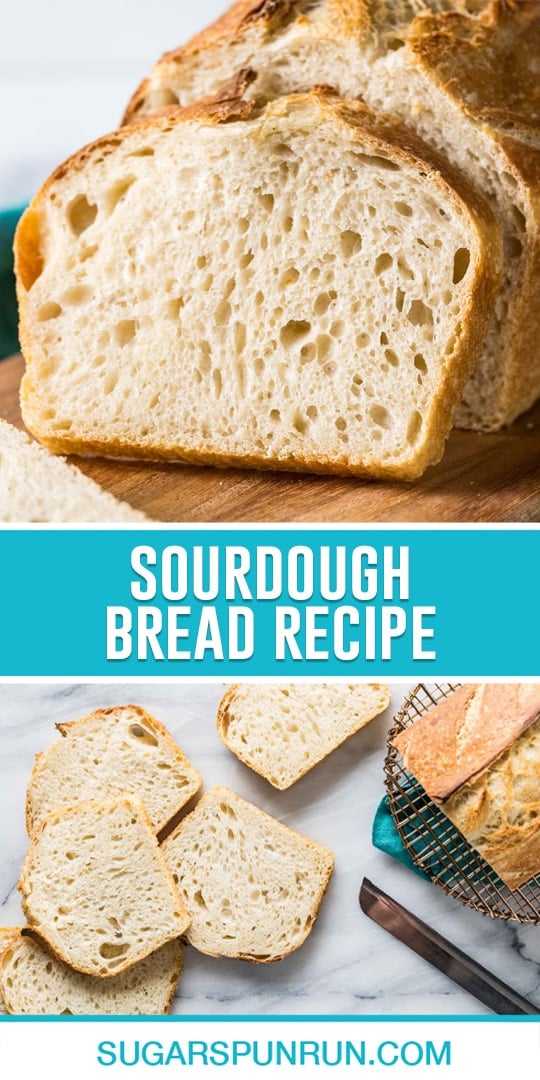
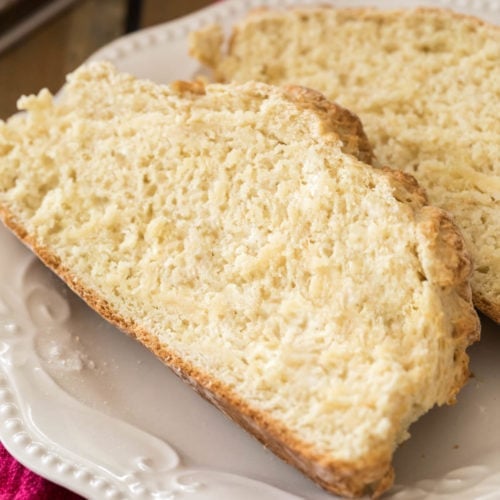
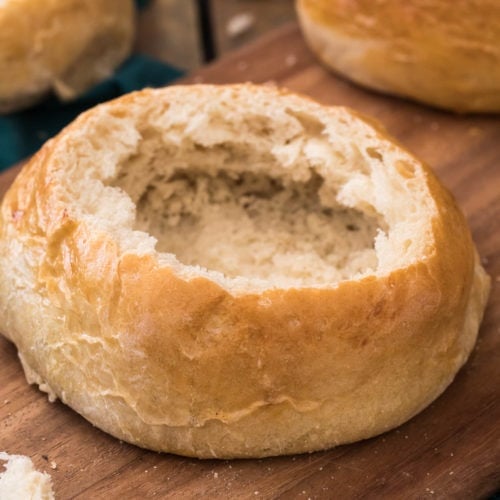
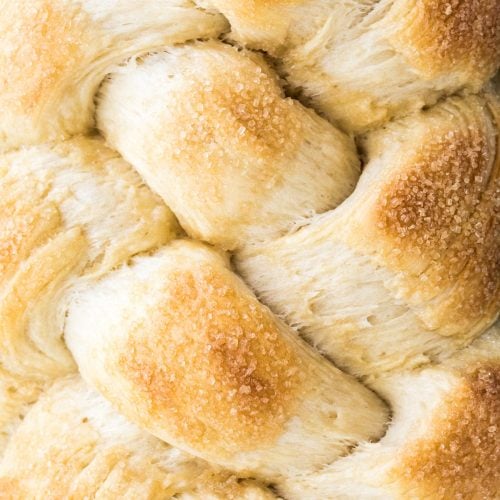
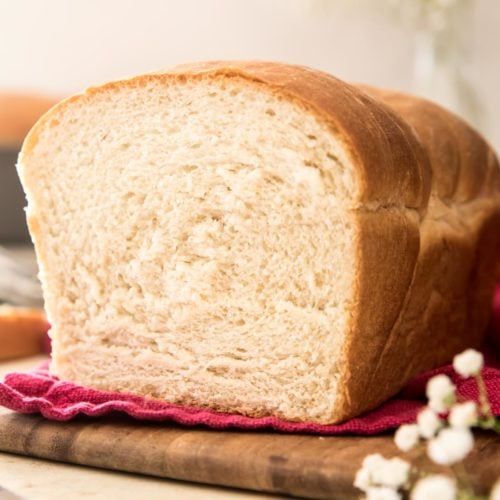




Julie
After reading reviews about the dough being too sticky, I initially only added 1 cup of water, and then kept adding a little more at a time until the dough was nice and shaggy. I also did not use bread flour, I used all purpose flour. I did a total of four stretch & folds before falling asleep. I proof (autolyse?) the dough in the oven with just the light on. so, the dough was in the oven for a good six hours after the four stretch & folds. It is the most gorgeous loaf of bread I’ve ever seen, and is just perfect in every way! Thank you so much for the recipe and the useful information.
Brian T.
I had the same problem of the dough being way to wet. I used a kitchen scale and my measurements were right on. This is the second time trying this recipe and think it must be my starter. Oh and this is my second attempt at sourdough ever.
Sam Merritt
I’m so sorry to hear this happened, Brian! It can be a pretty wet dough, but if you are using a scale and aren’t able to get to a workable consistency it may just be your starter. Is it a well established starter?
Jena
the first time I made this perfectly by measuring the flour in cups and the rest in grams. The second time I measured in all grams and it was way too wet but actually turned out AMAZING! it’s not your starter!
Kim
Thank you sooooo much! I was scared to make it without a Dutch oven. Thank you 🙂 love your recipes!
Essie
I’ve tried at least 5 different sourdough recipes with poor results. Found this recipe and my very first loaf was a SUCCESS!! This will be my go-to recipe going forward!
Michele Diedrich
Mine came out with a very dark crust, and d I was afraid that it was overdone. It was not. It was instead that beautiful, deep sourdough crust that you look forward to with that good chew and a soft tender interior. I just had a slice with butter with my morning coffee and it was pure heaven.
The only deviation from the recipe that I made was to add a teaspoon of diatastic malt powder. Which is designed to give you a deep dark crust which probably contributed to the delicious deep golden brown Which is designed to give you a deep dark crust which probably contributed to the delicious deep golden brown exterior.
Gail
This recipe is just WOW! Everyone I made this for loved it, even me!
Amy A. Griffiths
This recipe is so easy to prepare. My only issue is that I baked it exactly as directed and when I took the top bread pan off at 30 minutes, the loaf was already a beautiful golden brown. I set the timer for 17 minutes instead of 20 and the loaf had some burned spots. The interior was at 207 degrees. Should I decrease the temp to 425 degrees or shorten the covered time and the final bake time set at 450 degrees?
Sam Merritt
Hi Amy! Is your oven temperature accurate? If it starts to burn too much without being done you can tent it. I don’t recommend reducing the temperature.
Amy A. Griffiths
Update. I made another loaf this morning, baking at 425 and baking for an additional 12 minutes and it is the most lovely loaf of bread, and it smells incredible!
Mary
I love this recipe, I will never purchase sandwich bread again!!!!
Sri Koduri
I am surprised by how less intense this recipe is in terms of stretching the dough to build gluten. I haven’t baked it yet and hoping you have some input for me before I bake it tomorrow! Thanks
Sam Merritt
My best advice is to read through the post a couple of times so you know what to expect. Follow the instructions and you’ll be fine. 🙂
Dorothy
Have you ever made this recipe with a stand mixer and bread hook? If so, how long should it be mixed?
Sam Merritt
Hi Dorothy! I wouldn’t recommend a stand mixer here as you would run the risk of over-mixing the dough. 🙁
Laura
This is the best tasting sourdough bread I’ve ever had! I’m still fumbling through the bulk fermentation process and didn’t get the rise I was hoping for, but it was still every flavor of scrumptious. I love that the dough isn’t stingy on salt. Can’t wait to make it again. Thank you a million times! ♡♡♡
Derrick Lail
Do you have a honey wheat sourdough sandwich loaf recipe?
Sam Merritt
Unfortunately I do not. 🙁
Connie
do you think I could use my stand mixer for the flip and fold method, just a few seconds with the dough hook?
Sam Merritt
I would not recommend it. 🙁
Doris
Let your dough rise until increased in size by 80%, repeating the stretch and fold process every 30 minutes.
(what does this mean after the initial 4 stretch and fold in your steps)
Sam Merritt
Hi Doris! You will want to be repeating the stretch and fold process every 30 minutes until it has increased in size by about 80%. This typically takes anywhere between 4-6 hours depending on the conditions in your kitchen as well as other factors. 🙂
Krista
I followed this recipe exactly by weight, and the dough was seemed way higher than 70% hydration. I should’ve made focaccia with it. Next time I will add more flour!
Sam Merritt
Hi Krista! What do you mean by it seemed like higher than 70% hydration? How did the finished product turn out?
Krista Nenn
Hi Sam! It was SO sticky and loose! The bread actually turned out tasting ok but was very flat, didn’t rise in the oven at all. I couldn’t score it even after baking for 10 minutes. In hindsight I wonder if I screwed the measurements up. I’m relatively new to sourdough so don’t always catch it when something is off. I did the stretch and folds and every time my hands were covered in dough, it never seemed to change texture. It rose nicely after that, but was a sticky mess that I didn’t ‘shape’ exactly, just kind of plopped into the pan before sticking it in the fridge. Lol.
Sam Merritt
Hmmm, I would double-check the measurements and take a peek at the video to compare how your texture looked compared to mine. From what you’re describing, it actually sounds over-proofed honestly. Was your sourdough starter active?
Krista Nenn
Yes, the starter was active, and I considered overproofing but it didn’t change after the bulk fermentation, it was the same texture from the beginning. I think I’ll just try again and make sure I’m paying really close attention. Other than the complete lack of oven spring it turned out surprisingly well, though…a very forgiving recipe!